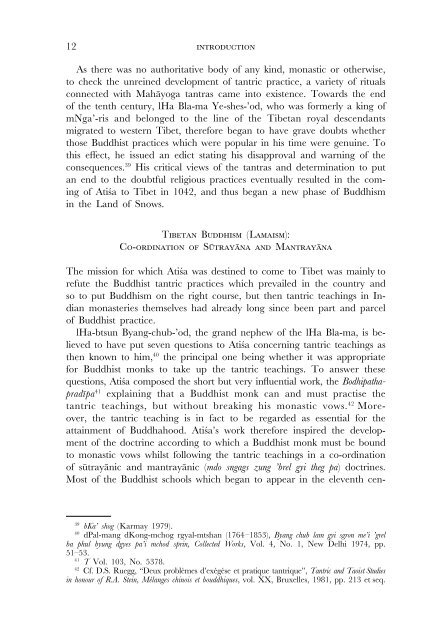You also want an ePaper? Increase the reach of your titles
YUMPU automatically turns print PDFs into web optimized ePapers that Google loves.
12 introduction<br />
As there was no authoritative body of any kind, monastic or otherwise,<br />
to check the unreined development of tantric practice, a variety of rituals<br />
connected with Mahàyoga tantras came into existence. Towards the end<br />
of the tenth century, lHa Bla-ma Ye-shes-’od, who was formerly a king of<br />
mNga’-ris and belonged to the line of the Tibetan royal descendants<br />
migrated to western Tibet, therefore began to have grave doubts whether<br />
those Buddhist practices which were popular in his time were genuine. To<br />
this effect, he issued an edict stating his disapproval and warning of the<br />
consequences. 39 His critical views of the tantras and determination to put<br />
an end to the doubtful religious practices eventually resulted in the coming<br />
of Ati≤a to Tibet in 1042, and thus began a new phase of Buddhism<br />
in the Land of Snows.<br />
Tibetan Buddhism (Lamaism):<br />
Co-ordination of Sùtrayàna and Mantrayàna<br />
The mission for which Ati≤a was destined to come to Tibet was mainly to<br />
refute the Buddhist tantric practices which prevailed in the country and<br />
so to put Buddhism on the right course, but then tantric teachings in Indian<br />
monasteries themselves had already long since been part and parcel<br />
of Buddhist practice.<br />
lHa-btsun Byang-chub-’od, the grand nephew of the lHa Bla-ma, is believed<br />
to have put seven questions to Ati≤a concerning tantric teachings as<br />
then known to him, 40 the principal one being whether it was appropriate<br />
for Buddhist monks to take up the tantric teachings. To answer these<br />
questions, Ati≤a composed the short but very influential work, the Bodhipathapradìpa<br />
41 explaining that a Buddhist monk can and must practise the<br />
tantric teachings, but without breaking his monastic vows. 42 Moreover,<br />
the tantric teaching is in fact to be regarded as essential for the<br />
attainment of Buddhahood. Ati≤a’s work therefore inspired the development<br />
of the doctrine according to which a Buddhist monk must be bound<br />
to monastic vows whilst following the tantric teachings in a co-ordination<br />
of sùtrayànic and mantrayànic (mdo sngags zung ’brel gyi theg pa) doctrines.<br />
Most of the Buddhist schools which began to appear in the eleventh cen-<br />
39 bKa’ shog (Karmay 1979).<br />
40 dPal-mang dKong-mchog rgyal-mtshan (1764–1853), Byang chub lam gyi sgron me’i ’grel<br />
ba phul byung dgyes pa’i mchod sprin, Collected Works, Vol. 4, No. 1, New Delhi 1974, pp.<br />
51–53.<br />
41 T Vol. 103, No. 5378.<br />
42 Cf. D.S. Ruegg, “Deux problèmes d’exégèse et pratique tantrique”, Tantric and Taoist Studies<br />
in honour of R.A. Stein, Mélanges chinois et bouddhiques, vol. XX, Bruxelles, 1981, pp. 213 et seq.

















